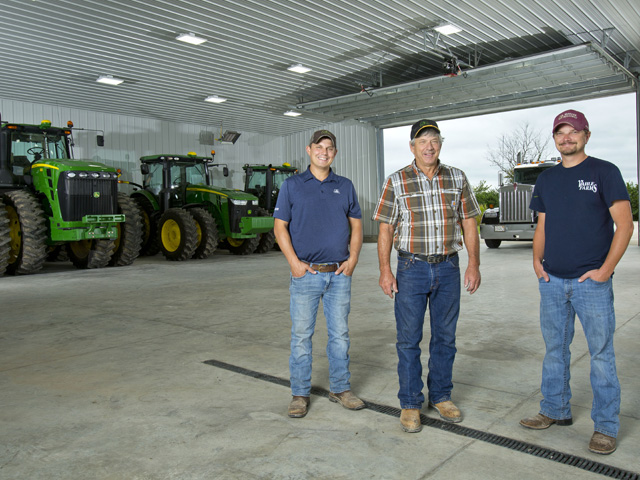Farm Shop Invests in Next Generation
Midwest Farm Shop Designed to Help Service, Store Equipment for Future
The Vahle operation, outside Jerseyville, Illinois, has been preparing for a generational change. As an investment in that future, Gary Vahle has invested in a 72-by-176-foot Morton Buildings shop that will give his sons, Brad and Brian, a leg up on their future service and maintenance needs.
The center of the shop features a 20-foot ceiling. It's the farm's second Morton structure, this one built over six weeks and located north of the Mississippi River town of Alton, Illinois.
"We needed another building for the boys that they can grow into," Gary said. The gray building, with a charcoal-colored band of wainscoting, was built to hold most of the farm's large line of equipment. "We can pretty well do what we need to do in here," Gary said.
The following are some of the features of the shop.
-- FINISHED AND NOT. The shop is divided into two main areas -- finished space and a large, cold storage space. The cold storage space was built to keep the farming equipment out of the weather.
The entire building sits on a poured concrete foundation wall rising 1 foot above the floor level. None of the building's three-member laminated columns are in contact with the ground. The columns are mounted to the top of the foundation wall with heavy fabricated steel U-shaped column sockets. The walls in the finished portion of the shop hold blankets of R-19 insulation. The ceiling is finished with acoustical panels; insulation was blown in over R-30 roll fiberglass insulation above the panels.
P[L1] D[0x0] M[300x250] OOP[F] ADUNIT[] T[]
-- TWO EXITS. The finished work area measures 72-by-72 feet. This space opens to the outside by way of two overhead doors (the doors each include a row of windows). A 32-foot-wide-by-16-foot-tall overhead door opens on the front of the building. The second overhead door, 18 feet wide by 15 feet tall, opens on one side of the building. Just inside this door is a large compressor with enough hose to reach any work parked outside on a concrete pad.
This area doubles as a wash bay, with wastewater taken away through a drainage grate in the floor. The Vahles added a nice design touch near the largest door. Insulated walk (or service) doors are located on the sidewalls of the building on either side of the overhead door. The two doors greatly improve access to the shop when the overhead door is closed. To dress up
the building a bit, they added three cupolas and a 3-foot-wide eyebrow overhang. The overhang offers cover over one of the walk doors during inclement weather.
The back portion of the building is 104-by-72 feet and is used for cold storage. A continuous 104-foot-long strip of translucent 3-foot-wide fiberglass panel is installed across the top of the back wall for lighting. Otherwise, this space is lighted by high bay LEDs. Entrance to the cold storage area is by way of an insulated walk door and a 34-foot-wide AlumaSteel sliding door. This space is large enough for semi-tractor trailers and combines.
The Vahles created a large, gravel staging area outside, giving all-weather access to the shop and a dry weather area for less complicated maintenance and repairs. There are concrete pads at each door. The Vahles want the rest of the area to settle before pouring additional concrete.
-- BUILT FOR WORK. This is a building equipped with a well-planned backbone. Noticeable are the numerous electrical outlets mounted to the interior walls. Power for the outlets is delivered inside through runs of PVC piping set under the floor.
Empty runs of PVC were added for future expansion. The shop is wired for welding in three locations.
Main shop lighting is provided by overhead LEDs, with six bulbs in each fixture. "They put out a lot of good light," Gary said. A handful of double-pane insulated windows are mounted around the shop, but most of the wall space has been preserved for future storage and work areas.
-- QUICK HEAT. Heat is provided by four ceiling-mounted radiant heaters -- one hanging from each of the four corners of the ceiling. The temperature in the shop can be held to about 40 degrees Fahrenheit in winter when no one is there. Gary says he can warm the space to about 60 F in only a few minutes.
The building has an office and kitchen space. The space is accessed from inside the finished shop, the actual square footage of the space carved out from the cold storage area on the other side of the wall. That keeps the main shop area square. The top of the office is used for storage accessed by a set of stairs.
"We can pretty much do what we want to do here," Brad said. "I like the overhead doors. We can pull in here and have a place to work. We have had problems getting stuff into and out of our other sheds."
Dan Miller can be reached at dan.miller@dtn.com
Follow him on Twitter @DMillerPF
(c) Copyright 2021 DTN, LLC. All rights reserved.




